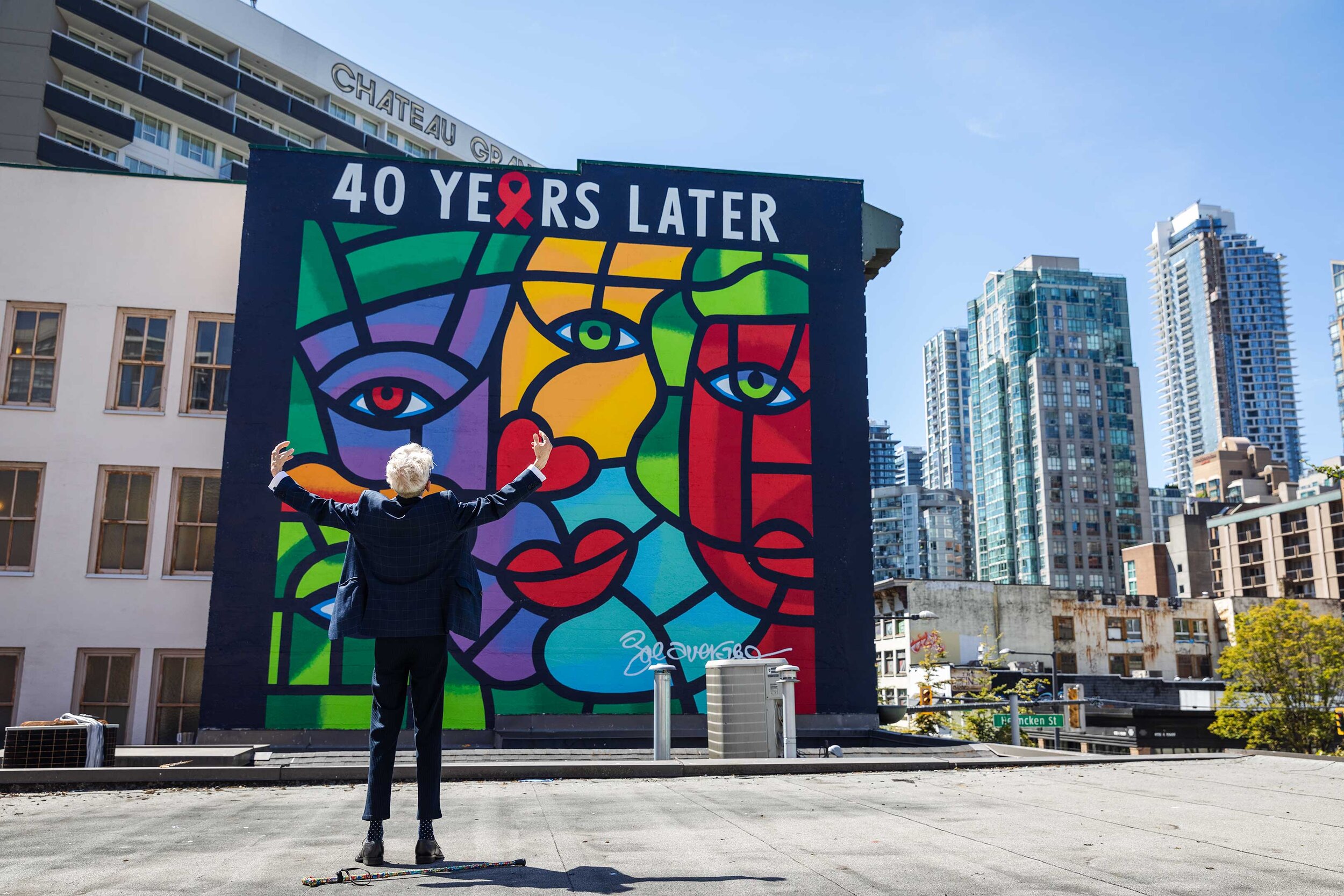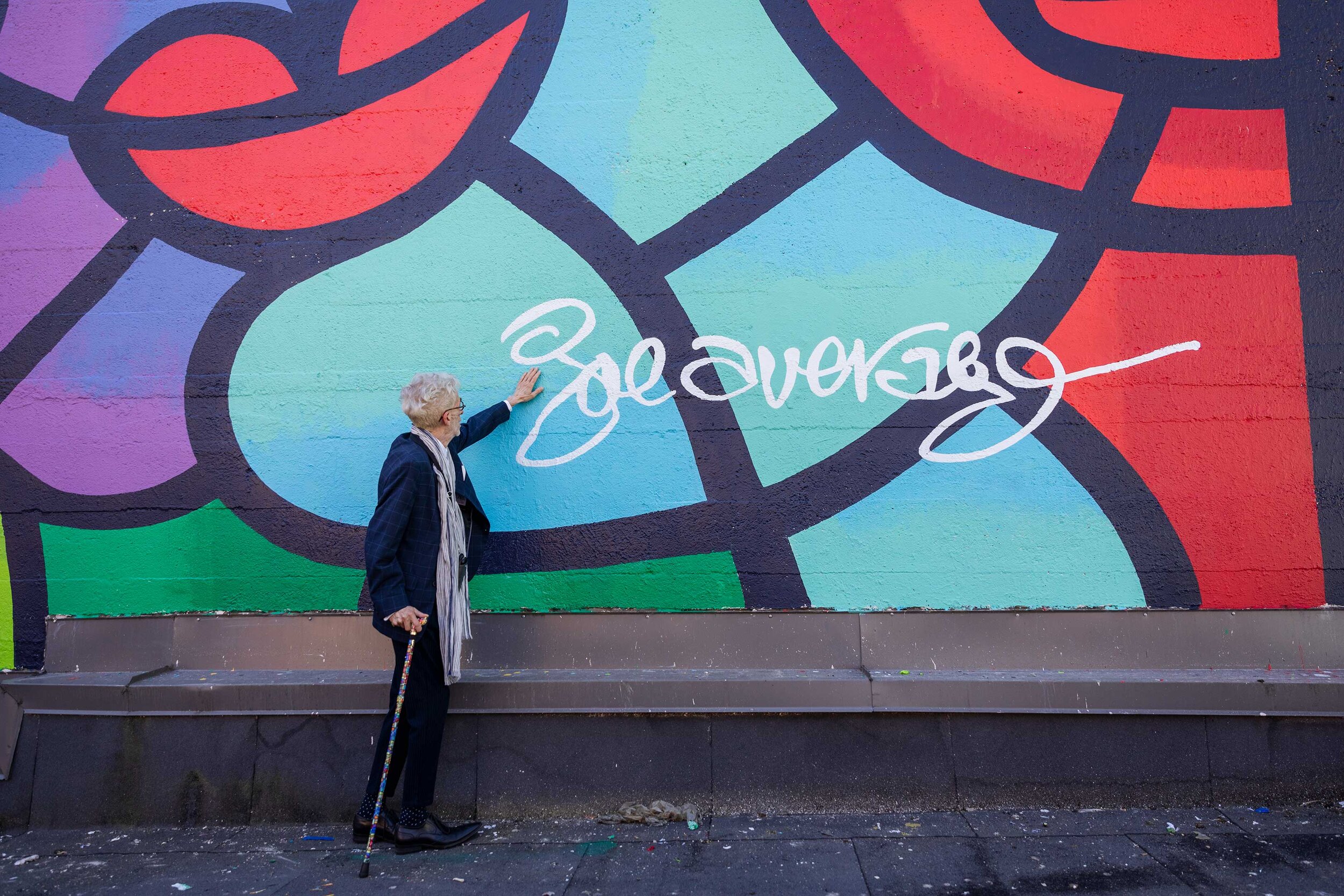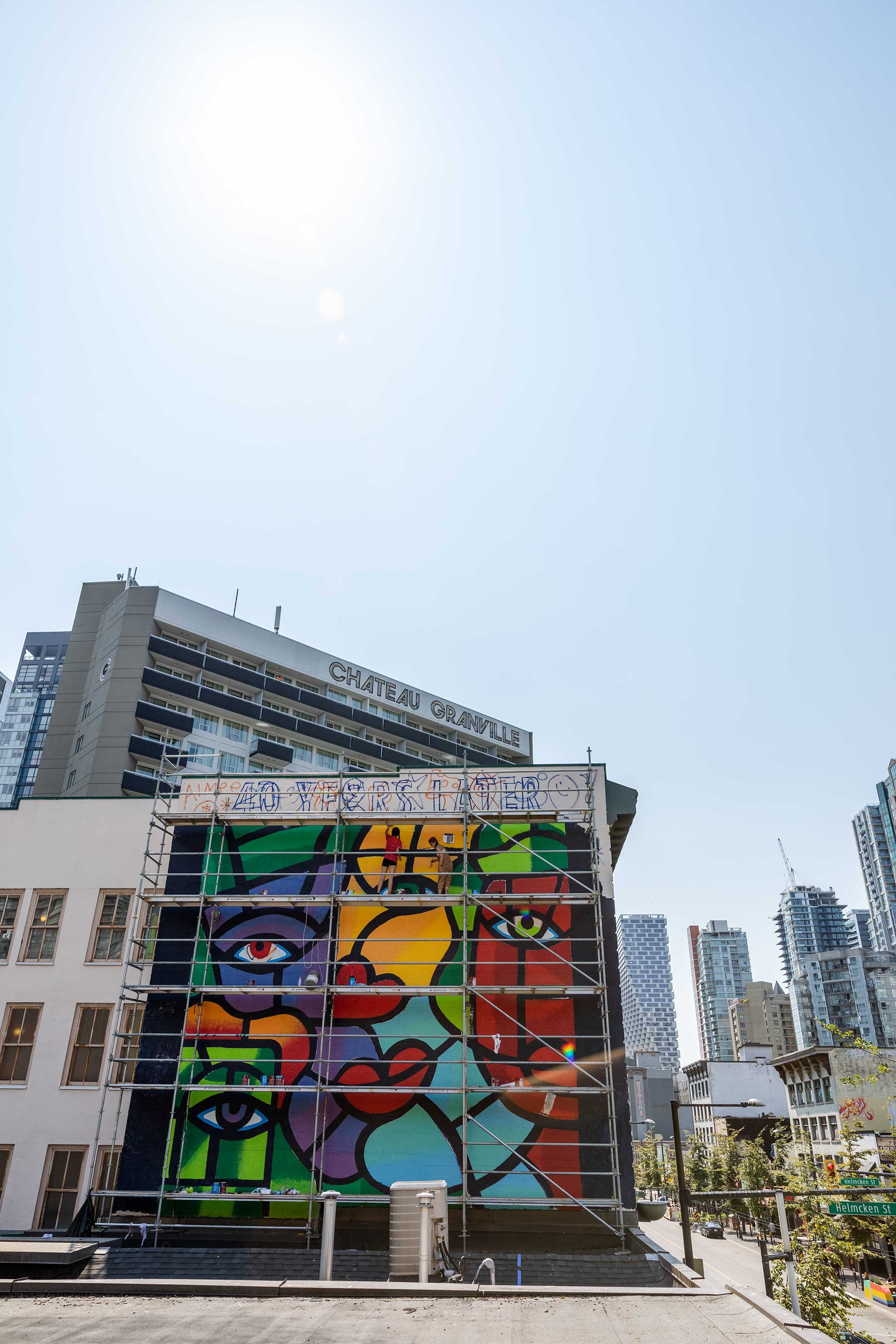Joe Average’s mural commemorates 40 years since the AIDS/HIV epidemic
Helmcken House is a building dedicated to providing affordable housing for those living with HIV/AIDS, led by the Mclaren Housing Society of British Columbia. This year, VMF was able to help facilitate a truly wonderful partnership between the Mclaren Housing Society and artist Joe Average, a deeply revered figure throughout British Columbia and across Canada.
Joe Average is an artist and philanthropist who threw himself into his creative endeavours and decided to follow his artistic passions in the 1980’s as an activist for the AIDS/HIV epidemic. With a bold, colourful, and uniquely stylised visual language, Joe’s work is distinct and recognisable. His art hangs proudly on the banners along Davie street, an iconic fragment of Vancouver’s visual symbolism. In 2019, the Royal Canadian mint released a coin embossed with a design by Joe, specifically commissioned to commemorate the 50th anniversary of the decriminalization of homosexuality in Canada. As this year marks the 40th anniversary of the HIV/AIDS epidemic, the mural for Helmcken House designed by Joe is symbolically poignant, serving as a reminder of the impact HIV/AIDS has towards its affected community.
We had the opportunity to speak with Kim Stacey, the executive director of McLaren Housing, to learn a little bit more about what the Housing Society does and how their work impacts the community throughout Vancouver and the lower mainland; as well as Joe Average, to hear what this mural means to him and what he hopes the public will take from it.
VMF: How did this project come together?
KS: “After a few years of being here, I thought it would be interesting to see if we could have a mural on the wall here because if you walk down Granville street it’s a very prominent wall, you can really see it as you come and walk south. I realised I needed to contact the city [and that] we had to be approved to do it, we had to find the money to do it, and at the same time we were having some repair work done. And so, when we got the funding from BC Housing to do that – I said can we prep that wall and seal it so it’s ready for a mural to go on it. It kind of sat like that, and then – Mavreen from VMF connected with me and said who she was and that she’d been in conversation with the DVBIA about murals for the summer festival. The DVBIA were interested in producing a mural on the wall here, and that’s how we connected.”
JA: “I’m very excited at the opportunity for this image to be displayed publicly again, because I think the image still resonates today and I’m thrilled that a new generation will be able to see it. I hope this reminds everyone of the work that is still needed in education, stigma removal, and funding research for crucial treatment and vaccines.”
“Having such a high visibility opportunity to reopen the dialogue and continue to share my own journey with a new generation is incredibly exciting for me.”
VMF: Can you tell us a little bit about McLaren Housing Society?
KS: “Mclaren housing society became a nonprofit in 1987, we’re named after Ted McLaren who was an early AIDS activist in Vancouver. [Ted’s parents] came to Vancouver, nursed him and cared for him, and when he died they could not find a funeral home that would accept his body. Because at the time, in the 80’s, with the epidemic, there was so much fear and stigma that this was quite common. That was when Mclaren house started, and we started with leasing a five bedroom house at 16th and Oak, on Douglas Crescent. They took in gay men that died because back in those days people died of AIDS, there were no drugs or very few drugs. In the early 90’s the society negotiated Helmcken house here at 649 Helmcken, it’s a heritage building.
We were Canada’s first HIV/AIDs housing provider, many of the people that have lived in this building died in the 80’s and 90’s. People still die today of AIDS, of HIV related issues. There have been huge advancements in the antiretrovirals, but there are also co-morbidities that occur when people are on these medications for a long time. One of the things that we try and work on is to continue to publicise the fact that people are still being diagnosed with HIV and people are still needing affordable housing who live with HIV because the stresses in life living with this virus are significant and a lot of our folks are unable to work full time, are often on long term disability and low income, and in a city like Vancouver, the ability for them to find affordable housing is very limited. So we have 32 units here of independent housing, we have 110 units of supportive housing at 1049 howe street that opened 7 years ago, we have 24/7 staffing there – life skills, support workers, people from that building come from a variety of backgrounds but a number of them have experienced significant homelessness in their lives.
We have around 300 individuals and families we work with in vancouver and across the lower mainland, we truly work with the whole diversity of the HIV community. We have people from the LGBT community, trans people, we work with rainbow refugees who housed their folks that are escaping violence in other countries, we work with families – we have a number of families, single parents families, particularly from the african continent that have experienced (awful? all?) situations, we work with a high percentage of indegenous people – women. We truly work with not just the stereotype of gay men or drug users, we work with the whole diveristy that makes up the HIV community.”
VMF: What is the significance of having this piece painted on the Helmcken House?
JA: Well, I was diagnosed with HIV in 1984, so it’s been about 37 years for me…. so many people think that AIDS/HIV is over because it’s not in the news anymore, but nothing could be further from the truth. AIDS is still with us, it’s still affecting our community, and we need to focus on education, share information in vulnerable groups, and work even harder to remove the stigma around the disease. Having such a high visibility opportunity to reopen the dialogue and continue to share my own journey with a new generation is incredibly exciting for me.”
KS: “…I knew that there needed to be some delicacy around what was put on the wall because one of the things that we still deal with as a community is a huge stigma. Obviously Joe Average is very well known to the community, personally I have a few of his prints, we have a number of them around Helmcken…I can see three of them now as I’m looking in the room.
Joe is someone who was politically active as an artist in the early days of HIV, and there were organizations such as ActUp which were active politically to raise awareness of AIDs and the need for the government to provide the drugs needed and to release the drugs so people did not die. At the time, one of their logos was “silence = death”, and Joe was someone who was not silent; he spoke up for this community and was a public figure at a time when many others could not do. It’s an absolute honour to have Joe design and approve this mural for this building, and I think it goes hand in hand with McLaren and the role McLaren plays and how out there McLaren was in 1987 and in the early 90’s when they moved into this building. Synergy. Who’d have thought that forty years later we would be having this mural on the building, but also, who’d have thought that forty years later people are still dying of AIDS – they would still be becoming HIV positive and there would still be no cure. What this mural does, it puts it back in the public realm, that forty years later HIV and AIDs is still in the community, and it’s still something that impacts people for the rest of their lives.”
VMF: What were some of the reactions from those living at Helmcken House to the news of this mural?
KS: I think there’s – comfort, he’s from the community so there’s a level of acceptance of the mural going on. He’s one of our guys, he lives with HIV, he’s a gay man, he’s from the community. So, he’s one of our people. If it was someone who wasn’t from the community, I think that would’ve made a difference.
VMF: Angelica Stirpe was the lead painter for translating your art into this mural. What was it like seeing it in the end?
JA: I’m super happy with how it turned out. [Angelica Stirpe] took so much care with my art and really [went] above and beyond… they took the time and care to actually make it look like the original by blending the colours together. I was super impressed that they took the time and care to do that.
We are honoured to have had Joe Average and his iconic art as a part of VMF2021. You can find the mural located Downtown at 649 Helmcken Street.
Make sure to download the VMF App to find 300+ more murals around Vancouver!
Note: these interviews were transcribed from recorded conversations with Joe Average and Kim Stacey and edited for clarity and brevity.




